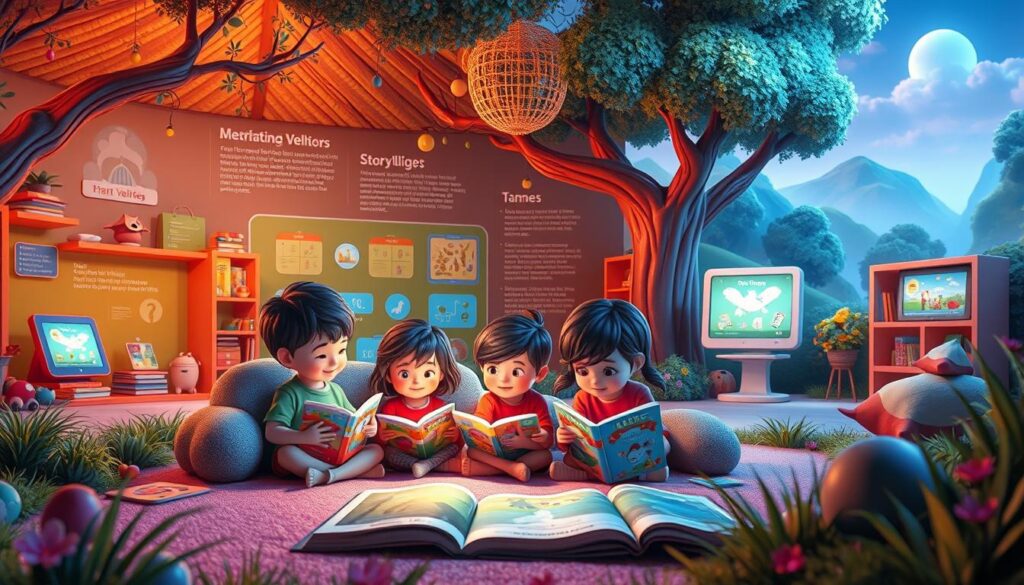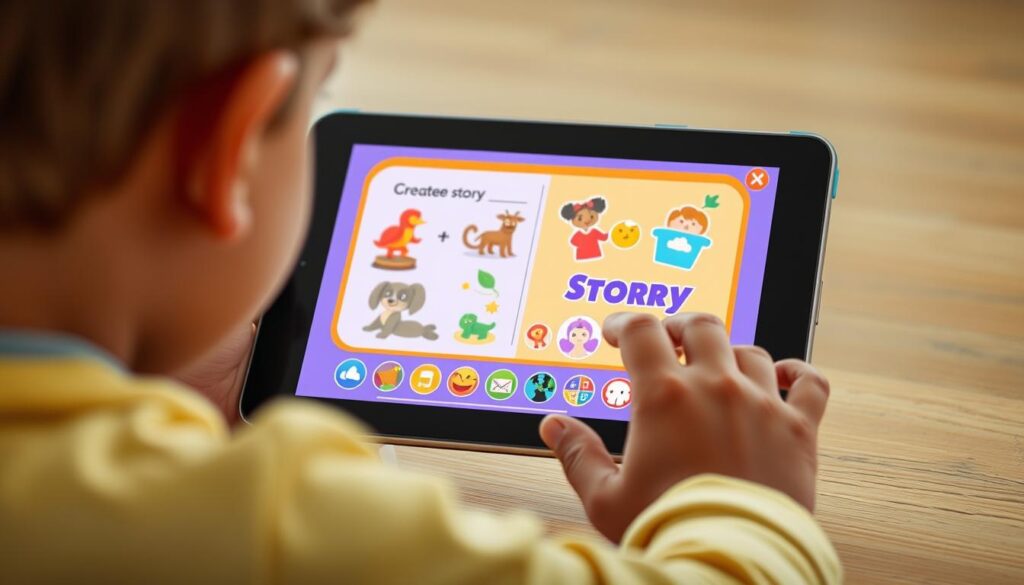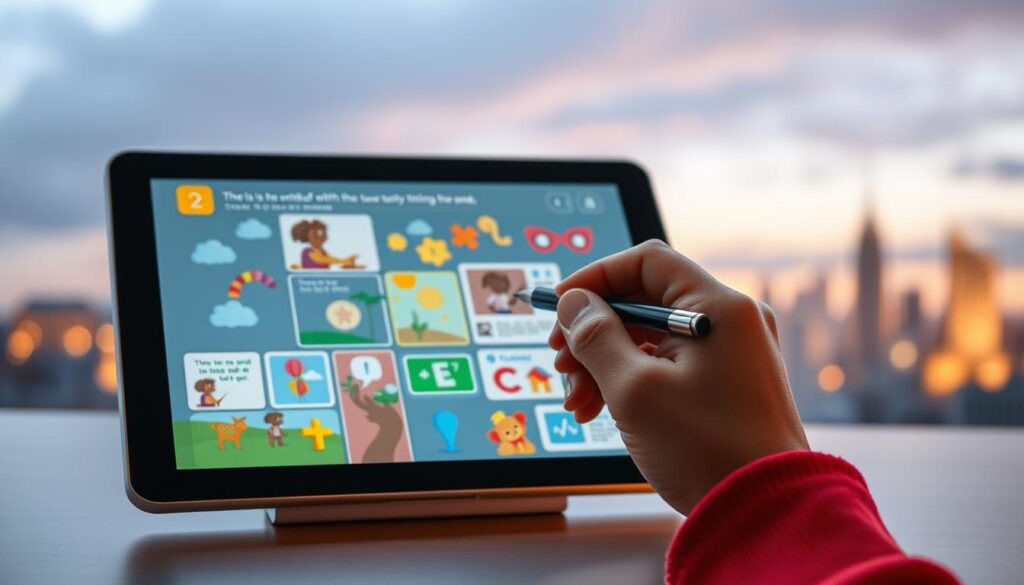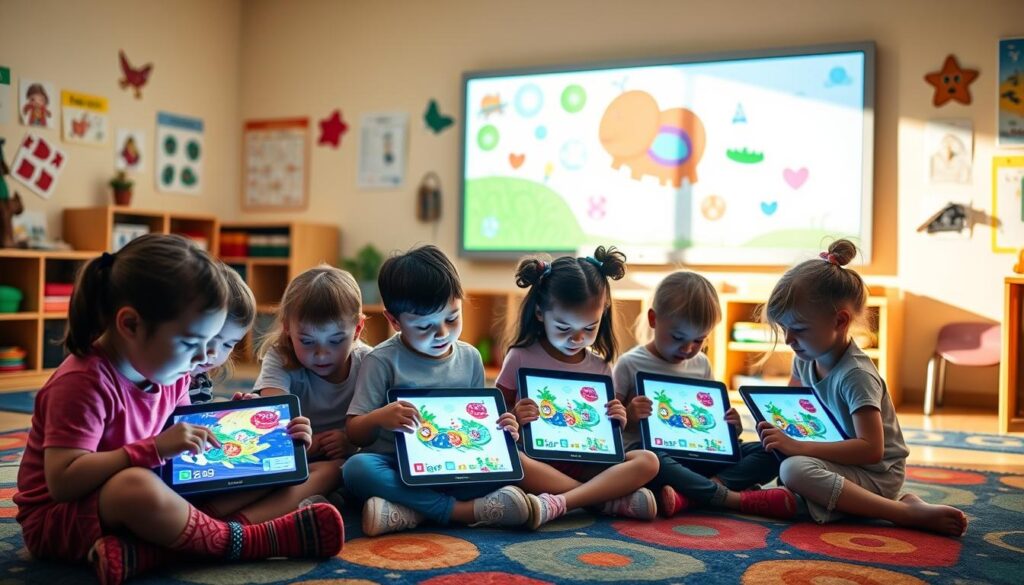As I reflect on my experiences in the classroom, I’m reminded of a powerful question: How can we harness the magic of stories to transform learning for our youngest students? The answer lies in the innovative approach of combining storytelling with modern technology, creating an engaging and interactive experience that goes beyond traditional teaching methods.
I’ve witnessed firsthand how this fusion of narrative and technology captivates children, encouraging them to participate actively in the learning process. By leveraging digital stories, educators can create a more immersive and inclusive environment that fosters learning and creativity.
The integration of storytelling in early childhood education represents a significant shift in how we approach learning experiences. By exploring the benefits and practical applications of this approach, we can unlock new possibilities for our children’s cognitive, linguistic, and creative development.
Understanding Digital Storytelling in Early Childhood Context
As we explore the world of early childhood education, it’s clear that digital storytelling is becoming an integral part of the learning process. I’ve seen firsthand how this engaging method can captivate young minds and foster a love for learning.
Digital stories are more than just videos; they encompass a broad range of multimedia formats and tools that allow students to communicate ideas effectively to an audience. These can include photographs, digital books, audio recordings, and more.
Defining Digital Storytelling for Young Learners
Digital storytelling for young learners is a creative process that combines narrative with digital elements like images, sound, and animation to create meaningful learning experiences. It’s not just about showing videos; it’s about engaging multiple senses and learning styles simultaneously, making concepts more accessible and memorable for young children.
- Engages multiple senses and learning styles
- Combines narrative with digital elements
- Creates meaningful learning experiences
How Digital Storytelling Differs from Traditional Storytelling
While storytelling has been a cornerstone of education for centuries, digital storytelling adds a new dimension to this traditional method. It incorporates visual, auditory, and interactive elements that today’s tech-savvy children naturally respond to, transforming them from passive listeners to active participants in their learning journey.
The interactive element of digital storytelling fosters agency and ownership over learning, providing young children with different entry points to engage with content and supporting diverse learning needs and preferences.
The Developmental Benefits of Digital Storytelling for Young Children
Digital storytelling offers a multitude of benefits for young children, enhancing their cognitive, social, and emotional development. As we explore these advantages, it becomes clear that digital storytelling is a valuable tool in early childhood education.
Cognitive and Language Development Benefits
Digital storytelling significantly boosts language skills by introducing new vocabulary in context, thereby enhancing language acquisition and communication skills. Through engaging story content, children naturally absorb complex sentence structures, fostering cognitive growth as they learn to sequence events and understand cause and effect. Storytelling sparks imagination, encouraging children to visualize characters and settings, which in turn fosters creativity.
Social and Emotional Growth Through Digital Stories
The process of creating and sharing digital stories builds crucial social-emotional skills like empathy, as children consider different perspectives within their narratives. By exploring diverse emotions through stories, children nurture empathy and understanding towards others. Digital storytelling creates a collaborative environment that fosters communication skills, turn-taking, and cooperative problem-solving.
Building Digital Literacy Skills Early
When young children participate in digital storytelling, they develop early digital literacy skills that prepare them for our technology-rich world. This process helps children practice executive function skills like planning and organizing information. By engaging with digital stories, children become familiar with technology in a meaningful way, laying the groundwork for future digital skills.

By integrating digital storytelling into early childhood education, educators can provide children with a comprehensive learning experience that supports their overall development. As children engage with digital stories, they not only enhance their language and cognitive skills but also develop essential social-emotional competencies.
Digital Storytelling Early Childhood Education: Research-Backed Advantages
As we explore the role of digital storytelling in early childhood education, it’s essential to examine the research supporting its effectiveness. The integration of digital storytelling into educational settings is not merely a technological trend; it’s a pedagogical approach backed by a growing body of research.
What Educational Research Reveals About Digital Storytelling
Research consistently shows that digital storytelling enhances early childhood learning experiences. Studies have demonstrated that creating visual explanations, a key component of digital storytelling, significantly improves science learning in young children (Bobek et al., 2016). The multimodal nature of digital storytelling helps children recognize broader concept applications, making abstract ideas more concrete and accessible. This approach supports differentiated instruction by providing multiple entry points for diverse learners, including those with special needs or language barriers.
Key findings from educational research include:
- Improved science learning through visual explanations
- Enhanced recognition of broader concept applications
- Support for differentiated instruction
Measuring the Impact on Early Learning Outcomes
Studies measuring the impact of digital storytelling show that it creates more equitable learning environments where children of varying abilities can demonstrate their understanding in personalized ways. The research-backed advantages of digital storytelling extend beyond academic outcomes to include increased engagement, motivation, and positive attitudes toward learning—all critical factors for early educational success.
| Learning Outcome | Impact of Digital Storytelling |
|---|---|
| Vocabulary Acquisition | Measurable improvements |
| Narrative Comprehension | Enhanced understanding |
| Expressive Language Skills | Significant development |
In conclusion, the research-backed advantages of digital storytelling in early childhood education are multifaceted, enhancing not only academic outcomes but also promoting a positive attitude towards learning. As educators and parents, embracing this approach can lead to more engaging, effective, and equitable learning experiences for young children.
Essential Tools and Technologies for Classroom Digital Storytelling
Digital storytelling has become an integral part of modern early childhood education, but what tools should educators use? As we explore the world of digital storytelling, it’s essential to identify the right technologies that can enhance the learning experience for young children.

Age-Appropriate Apps and Platforms
When it comes to digital storytelling, the right apps and platforms can make all the difference. I’ve found that age-appropriate apps like Seesaw, Book Creator, and ChatterPix Kids offer intuitive interfaces that allow even our youngest learners to create digital stories with minimal adult assistance. These tools put children in the driver’s seat while providing appropriate scaffolding for their developmental level.
Hardware Considerations for Early Childhood Settings
You don’t need expensive equipment to start digital storytelling. Most tablets and smartphones already have the basic tools (camera, microphone, and simple editing apps) needed to help children create meaningful digital stories. When choosing hardware, consider difficulty, simplicity, and accessibility to ensure that the technology supports the learning objectives rather than hindering them.
Low-Tech and No-Tech Alternatives
For classrooms with limited technology access, hybrid approaches combining traditional storytelling methods with simple digital documentation (like photographing child-created artwork) can be equally effective. The best digital storytelling tools for young children maintain a healthy balance between technological engagement and hands-on, sensory learning experiences that are developmentally appropriate.
Integrating Digital Storytelling Across the Early Childhood Curriculum
I’ve seen firsthand how digital storytelling can be integrated into different areas of the early childhood curriculum to create a more holistic learning environment. By weaving digital storytelling throughout various subjects, educators can develop a curriculum that is not only informative but also engaging and interactive for young minds.
Storytelling in Language Arts and Literacy
Digital storytelling naturally enhances literacy development as children create and interact with stories, building comprehension, vocabulary, and narrative skills through authentic communication. For instance, children can create their own digital books, fostering a love for reading and writing. You can explore more about how stories enhance language growth on Lunesia’s Language Growth Through Stories page.
Using Digital Stories for STEM Concepts
STEM concepts become accessible and exciting when presented through digital stories. I’ve seen children grasp complex ideas like life cycles and simple machines when they’re embedded in narrative contexts. For example, a story about a character who goes on a journey through the water cycle can help children understand this complex process in an engaging way.
Cultural Learning and Social Studies Through Digital Narratives
Cultural learning and social studies come alive through digital narratives that introduce young children to diverse perspectives, traditions, and experiences beyond their immediate environment. By using digital storytelling, educators can help children develop empathy and understanding of different cultures.
Here’s an example of how digital storytelling can be integrated across different subjects:
| Subject | Digital Storytelling Example |
|---|---|
| Literacy | Creating digital books with illustrations and text |
| STEM | Narrating the journey of a water molecule through the water cycle |
| Social Studies | Sharing stories about different cultures and traditions |
By integrating digital storytelling across the curriculum, educators can create a more cohesive and engaging learning experience. This approach not only enhances literacy and STEM understanding but also fosters cultural awareness and social-emotional learning.
Step-by-Step Implementation Strategies for Educators
As an educator, you’re likely eager to integrate digital storytelling into your teaching practices, but you might be wondering where to start. The key is to begin small and build gradually. Start by taking a single assignment, like a report or presentation, and transform it into a digital storytelling project. For instance, you could have your students create an explainer video or podcast instead of a traditional written report.
Planning Your First Digital Storytelling Project
When planning your first digital storytelling project, focus on the learning objectives first. Let the technology serve as a tool rather than driving the experience. Keep your stories short and engaging—a 1-3 page book or a 60-second video is a good starting point. Use the resources you have available; most smartphones and tablets come equipped with cameras and microphones, and apps like Canva or Adobe Express can be easily downloaded.
Guiding Children Through the Creation Process
When guiding children through the digital storytelling process, it’s essential to provide clear, step-by-step guidance. Break the creation process into manageable stages: planning, gathering materials, creating, editing, and sharing. This helps young children stay engaged without feeling overwhelmed. As educators, you play a crucial role in asking open-ended questions that prompt deeper thinking while offering support at challenging moments.

Showcasing and Celebrating Children’s Digital Stories
Creating opportunities for children to share stories with authentic audiences validates their work and motivates them to communicate effectively. Whether it’s through a classroom presentation, a school website, or a community event, letting students tell stories and share stories with others is a powerful way to reinforce their learning. The celebration and reflection phase is where much of the learning becomes solidified, as children articulate their creative choices and consider how they might approach future storytelling projects.
By following these steps and embracing digital storytelling, you can create a rich and engaging learning environment that fosters creativity, communication, and critical thinking in your students.
- Begin with simple projects that replace traditional assignments.
- Focus on learning objectives, using technology as a tool.
- Break the creation process into manageable stages.
- Create opportunities for children to share their stories with authentic audiences.
Overcoming Common Challenges in Early Childhood Digital Storytelling
Digital storytelling, while beneficial, presents several challenges in early childhood settings that require thoughtful solutions. As educators, we must be aware of these challenges and address them effectively to ensure a smooth integration of this tool into our teaching practices.
Managing Screen Time Concerns
I understand the concerns about screen time in early childhood, which is why I approach digital storytelling as a purposeful, interactive tool rather than passive consumption of media. Balancing technology use with hands-on experiences is essential. For instance, you can use digital elements as one component within a broader storytelling approach that includes physical materials and face-to-face interaction. This balanced approach helps in managing screen time effectively.
Supporting Diverse Learning Needs
Digital storytelling can be a powerful tool for supporting diverse learning needs, as it offers multiple means of engagement, representation, and expression aligned with Universal Design for Learning principles. By incorporating various digital elements, educators can cater to different learning styles, ensuring that all children have the opportunity to engage with the story in a meaningful way.
Addressing Technical Limitations in Educational Settings
When faced with technical limitations, educators can develop creative solutions. For example, creating technology stations, utilizing parent volunteers, and implementing a gradual release approach can help build children’s independence over time. For classrooms with limited technology access, rotating small groups through digital storytelling activities while others engage in related hands-on experiences ensures all children benefit.
| Challenge | Solution |
|---|---|
| Managing Screen Time | Balancing technology with hands-on experiences |
| Diverse Learning Needs | Using Universal Design for Learning principles |
| Technical Limitations | Creating technology stations and rotating activities |
For more information on age-appropriate apps and platforms for digital storytelling, you can visit https://lunesia.app/story-apps-for-preschoolers/. This resource can provide valuable insights into selecting the right digital tool for your classroom.
Case Studies: Successful Digital Storytelling Projects in Early Childhood Settings
I’ve witnessed firsthand how digital storytelling projects can transform learning environments for young children. By engaging in these projects, children not only develop essential skills but also share their experiences and connect with their community. Let’s explore some inspiring examples.
Preschool Digital Book Creation Project
In a preschool classroom, children created a collaborative digital book about their community helpers. By combining photographs from field trips with their recorded observations and questions, they developed a rich narrative that showcased their understanding of the world around them. This project demonstrated how digital storytelling can be used to foster community awareness and literacy skills from an early age.
Kindergarten Community Storytelling Initiative
A kindergarten class embarked on a year-long digital storytelling project that documented their experiences growing a garden. This initiative integrated various subjects, including science, math, literacy, and social-emotional learning, providing a holistic learning experience. By sharing their stories through digital narratives, the children reflected on their journey and the lessons they learned.
Family Engagement Through Shared Digital Narratives
Digital storytelling also offers a powerful means of engaging families in their children’s learning. When children share stories digitally, parents can access and contribute to these narrative projects, fostering a sense of connection and cooperation between home and school. This approach has been shown to increase family engagement and encourage children to continue exploring their creativity.
These case studies highlight the potential of digital storytelling to create meaningful learning experiences and strengthen community bonds. By embracing this approach, educators can empower young children to become confident creators and communicators, shaping their own stories and narratives.
Conclusion: Embracing the Future of Storytelling in Early Education
In the rapidly evolving landscape of early childhood education, digital storytelling stands out as a beacon of innovation and creativity. As we look to the future, it’s clear that this approach has tremendous potential to nurture the skills and dispositions children need for success.
I believe that when implemented thoughtfully, digital storytelling honors the developmental needs of young children while introducing them to technology as a creative tool for self-expression and learning. By blending traditional and digital approaches, we can create rich, multisensory learning experiences that respect children’s capabilities.
As educators and parents, we have the opportunity to harness storytelling to help children find their voices, tell their story, and see themselves as authors of their own learning journeys. I encourage you to start small, experiment playfully, and discover how digital storytelling can transform your early childhood setting into a place where children’s story and potential can truly flourish.
FAQ
How can I help my child develop their language skills through storytelling?
You can encourage your child to tell stories by listening to them and asking open-ended questions. This will help them develop their vocabulary and communication skills. You can also engage in storytelling activities together, like creating a story and sharing it with family members.
What are some effective ways to integrate storytelling into my child’s learning experiences?
You can incorporate storytelling into daily routines, such as before bedtime or during meals. You can also use storytelling to teach various subjects, like science and math, by creating narratives that make complex concepts more engaging and accessible.
How can educators use technology to enhance the storytelling experience for young learners?
Educators can utilize a range of tools, such as apps and platforms, to create interactive and immersive storytelling experiences. These can help children develop their creativity, critical thinking, and problem-solving skills.
What are some benefits of using digital narratives in the classroom?
Digital narratives can help children develop their digital literacy skills, including understanding how to effectively use technology to communicate ideas. They can also enhance engagement and motivation, particularly for children who may struggle with traditional teaching methods.
How can I support my child’s teacher in incorporating storytelling into their curriculum?
You can offer to help with storytelling activities, such as recording your child’s story or assisting with technology. You can also ask the teacher about their approach to storytelling and offer suggestions or resources that you think might be helpful.
What are some ways to assess the effectiveness of storytelling in my child’s learning?
You can observe your child’s participation and engagement during storytelling activities, as well as their ability to recall and retell stories. You can also discuss with their teacher how storytelling is being used to support learning objectives and assess its impact on their progress.




